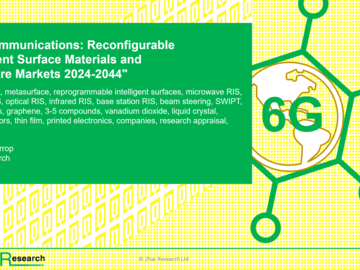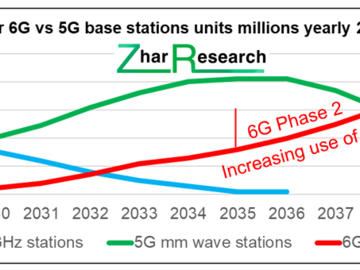Reconfigurable Intelligent Surfaces RIS in 2024
The 2030 launch date for 6G Communications is approaching and for that RIS will not be an afterthought – it will be essential. Importantly, if we are not to go the way of 5G with its over-promising, then 6G must largely operate at the much higher frequencies essential to its promised superlative performance. That means around 0.1-0.3THz, not confined to indoors, with higher later.
Considerable progress and vision in 2023
There has been good progress on precisely which frequencies that means. 2023 has also seen continuing experiments with small reflective and reprogrammable intelligent surfaces, mostly at megahertz frequencies.
Analyst Zhar Research shares the positivity it sees in the 2023 paper, “Terahertz Communications and Sensing for 6G and Beyond: A Comprehensive View” (2023) arXiv:2307.10321v1. This advises that the 6G-and-beyond systems will be revolutionized by the tremendous potential of RIS and THz, the two cutting-edge enablers for the access domain of a futuristic communications and sensing network. The authors note that synergy between RIS and THz lies in the fact that RIS can be utilized to improve the performance of THz systems by providing a cost-effective solution to the propagation challenges associated with THz frequencies. By controlling the phase, amplitude, and polarization, RIS can effectively steer, reflect, and amplify electromagnetic waves in THz systems and networks, enabling a vast array of applications and use-case scenarios, including beamforming, wireless power transfer, and indoor localization, among others.
The authors add that, by employing RIS-assisted spatial modulation, the THz-RIS systems and networks have the potential to dramatically improve their spectral efficiency. RIS can even be used to generate virtual channels that compensate for the propagation losses of THz waves in order to increase signal to noise ratio SNR and the coverage area of THz communications and sensing. They observe that the intersection between these two technologies has been dramatic, including for massive MIMO, millimeter wave, 3D beamforming, satellite networks, and many others. A large number and various types of physical layer-related optimization problems have been jointly investigated.
Other progress
Another recent review of academic work is, “Wireless Communications beyond Antennas: The Role of Reconfigurable Intelligent Surfaces” Eng. Proc. 2023, 32(1), 10. It concludes that RIS can improve the capacity and coverage, reducing energy consumption and latency. Specific challenges were addressed in other scientific papers such as, “Configuring Reconfigurable Intelligent Surfaces Using a Practical Codebook Approach” Scientific Reports 13, 11869 (2023) and “Secure Networking with Software Defined Reconfigurable Intelligent Surfaces” Sensors (Basel) 2023 Mar 23(5) 2726.
Different challenges need attention in 2024
Dr Peter Harrop, CEO of Zhar Research, cautions that,
“For those sub-THz RIS essential to 6G because of the small ranges, most of the important development is ahead of us. There are working spectrally reflective surfaces, some even in the form of transparent layers on windows, and they will be of some assistance, but we need to strengthen the beam at least by collimation and directing it where it is required in real time. That means semi-passive metasurfaces truly reconfigurable electronically. Experimental demonstrations of these are mainly at mere GHz frequencies and that is a start. However, if 6G Communications ends up mainly at these frequencies its whole rationale is blown. An additional challenge for 2024 is that some active RIS may be needed even at the start of 6G, so the system can know the propagation-path RIS. RIS technology also needs be used to contain the cost and power consumption of the planned UM-MIMO base stations and, in most cases, RIS must be much larger than the experimental ones – even fitted as facades on large buildings. ”
Power consumption and affordability
As the amount of data handled has exceeded the improvements in efficiency of data handling, the various generations of communications have seen base stations jump from kW to tens of kW. Will the planned UM-MIMO base stations for 6G, with co-located data processing, be both unaffordable in the required numbers and consume up to one megawatt? If such power is needed, can it feasibly be provided on-site using wind and solar power with long-duration energy storage? A new Zhar Research report has given some optimism on that. It is, “ Long Duration Energy Storage LDES beyond grids: markets, technologies for microgrids, minigrids, buildings, industrial processes 0.1-500MWh 2024-2044”.
Now show us wide area RIS
For RIS enhancing the propagation path, wide areas need to be demonstrated in 2024. Zhar Research finds that the cost will not lie in the hardware but in the space rental, installation and maintenance so designs that minimise these need to be proven in 2024. To that end, it supports the recommendation in “Wireless Communications beyond Antennas: The Role of Reconfigurable Intelligent Surfaces” Eng. Proc. 2023, 32(1), 10. that 2024 must see focus on integration of RIS into existing infrastructure, including inner and outer walls, windows and ceilings to ensure viability.
The big picture 2024-2044
The big picture has to embrace 2024-2044 because, for example, a Phase 2 of 6G adding the stellar performance of 0.3-1THz is unlikely to be deployed before 2035. Indeed, investor bait such as widely deployed active RIS enabling unpowered client devices may need to be later than that. That big picture is uniquely available in the Zhar Research report, “6G Communications Reconfigurable Intelligent Surface Materials and Hardware Markets 2024-2044”. It analyses the evolving 6G RIS needs, the latest research pipeline, the limitations of the physics and manufacturing technology and the experiments and intentions. Its resulting deliverables include detailed roadmaps and forecasts 2024-2044. There is also a sister report on the large 6G optical materials opportunities from far infrared to visible. For those requiring a broader overview of all 6G materials and hardware there is Zhar Research report, “6G Communications: Materials and Hardware Markets and Technology 2024-2044”. See www.zharresearch.com and www.giiresearch.com.
Press release distributed by Pressat on behalf of Zhar Research , on Thursday 23 November, 2023. For more information subscribe and follow https://pressat.co.uk/
Ldes Ris 6g 5g Telecoms Future 2024 Technology Wireless Communications Materials Hardware Microgrids Megahertz Frequency Computing & Telecoms Consumer Technology Education & Human Resources Manufacturing, Engineering & Energy
Published By

anastasiams@zharresearch.com
https://www.zharresearch.com/
Dr Peter Harrop
peterharrop@zharresearch.com
Visit Newsroom
You just read:
Reconfigurable Intelligent Surfaces RIS in 2024
News from this source:



